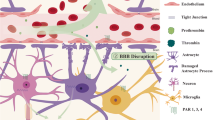Abstract
Thrombin, a central factor in thrombogenesis, affects cells in the brain through protease activated receptors. Low levels of thrombin activity are neuroprotective while higher levels are deleterious, and we have therefore developed a new method for its direct quantitative measurement in brain slices following stroke. Thrombin activity was measured by a fluorescent substrate on fresh coronal slices taken from the ipsilateral and contralateral hemispheres 24–72 h following permanent right middle cerebral artery occlusion. Prolyl endopeptidase and aminopeptidases were inhibited as a critical step to insure the specificity of the assay for thrombin detection. Infarct volume was assessed using TTC staining. Thrombin activity in the right ischemic hemisphere was significantly higher compared to the contralateral hemisphere (32 ± 6 and 27 ± 10 mU/ml, mean ± SE in the two most affected slices from the ischemic hemisphere vs. 21 ± 6 and 8 ± 2 mU/ml in corresponding contralateral slices; p < 0.05). Thrombin levels in the ischemic and contralateral hemispheres were significantly higher compared to healthy control mice and were above the range known to be protective to brain cells. A significant correlation was found between thrombin activity in the ischemic hemisphere and the infarct volume. Results of studies based on this method may translate into potential thrombin based therapies.




Similar content being viewed by others
References
Bar-Shavit R, Hruska KA, Kahn AJ, Wilner GD (1986) Hormone-like activity of human thrombin. Ann N Y Acad Sci 485:335–348
Beilin O, Gurwitz D, Korczyn AD, Chapman J (2001) Quantitative measurements of mouse brain thrombin-like and thrombin inhibition activities. Neuroreport 12:2347–2351
Belayev L, Busto R, Zhao W, Fernandez G, Ginsberg MD (1999) Middle cerebral artery occlusion in the mouse by intraluminal suture coated with poly-L-lysine: neurological and histological validation. Brain Res 833:181–190
Camilo O, Goldstein LB (2004) Seizures and epilepsy after ischemic stroke. Stroke 35:1769–1775
Chen B, Cheng Q, Yang K, Lyden PD (2010) Thrombin mediates severe neurovascular injury during ischemia. Stroke 41:2348–2352
Chen B, Friedman B, Whitney MA et al (2012) Thrombin activity associated with neuronal damage during acute focal ischemia. J Neurosci 32:7622–7631
Coughlin SR (2000) Thrombin signalling and protease-activated receptors. Nature 407:258–264
Desmond DW, Moroney JT, Sano M, Stern Y (2002) Incidence of dementia after ischemic stroke: results of a longitudinal study. Stroke 33:2254–2260
Festoff BW, Smirnova IV, Ma J, Citron BA (1996) Thrombin, its receptor and protease nexin I, its potent serpin, in the nervous system. Semin Thromb Hemost 22:267–271
Gingrich MB, Traynelis SF (2000) Serine proteases and brain damage—is there a link? Trends Neurosci 23:399–407
Henrich-Noack P, Striggow F, Reiser G, Reymann KG (2006) Preconditioning with thrombin can be protective or worsen damage after endothelin-1-induced focal ischemia in rats. J Neurosci Res 83:469–475
Hua Y, Wu J, Keep RF, Hoff JT, Xi G (2003) Thrombin exacerbates brain edema in focal cerebral ischemia. Acta Neurochir Suppl 86:163–166
Junge CE, Sugawara T, Mannaioni G et al (2003) The contribution of protease-activated receptor 1 to neuronal damage caused by transient focal cerebral ischemia. Proc Natl Acad Sci U S A 100:13019–13024
Kameda K, Kikkawa Y, Hirano M, Matsuo S, Sasaki T, Hirano K (2012) Combined argatroban and anti-oxidative agents prevents increased vascular contractility to thrombin and other ligands after subarachnoid haemorrhage. Br J Pharmacol 165:106–119
Kawabata S, Miura T, Morita T et al (1988) Highly sensitive peptide-4-methylcoumaryl-7-amide substrates for blood-clotting proteases and trypsin. Eur J Biochem 172:17–25
Longa EZ, Weinstein PR, Carlson S, Cummins R (1989) Reversible middle cerebral artery occlusion without craniectomy in rats. Stroke 20:84–91
Maggio N, Shavit E, Chapman J, Segal M (2008) Thrombin induces long-term potentiation of reactivity to afferent stimulation and facilitates epileptic seizures in rat hippocampal slices: toward understanding the functional consequences of cerebrovascular insults. J Neurosci 28:732–736
Maggio N, Itsekson Z, Dominissini D et al (2013) Thrombin regulation of synaptic plasticity: Implications for physiology and pathology. Exp Neurol
Masada T, Xi G, Hua Y, Keep RF (2000) The effects of thrombin preconditioning on focal cerebral ischemia in rats. Brain Res 867:173–179
Nicholson CCK, Hrabĕtová S, Tao L (2000) Diffusion of molecules in brain extracellular space: theory and experiment. Prog Brain Res 125:129–154
Noorbakhsh F, Vergnolle N, Hollenberg MD, Power C (2003) Proteinase-activated receptors in the nervous system. Nat Rev Neurosci 4:981–990
Papadopoulos Marios CDKB, Verkman AS (2005) Enhanced macromolecular diffusion in brain extracellular space in mouse models of vasogenic edema measured by cortical surface photobleaching. FASEB J 19:425–427
Shah Zahoor Ahmad NK, Klaus J, Kibler K, Doré S (2006) Use of an optimized transient occlusion of the middle cerebral artery protocol for the mouse stroke model. J Stroke Cerebrovasc Dis 15:133–138
Shavit E, Michaelson DM, Chapman J (2011) Anatomical localization of protease-activated receptor-1 and protease-mediated neuroglial crosstalk on peri-synaptic astrocytic endfeet. J Neurochem 119:460–473
Striggow F, Riek M, Breder J, Henrich-Noack P, Reymann KG, Reiser G (2000) The protease thrombin is an endogenous mediator of hippocampal neuroprotection against ischemia at low concentrations but causes degeneration at high concentrations. Proc Natl Acad Sci U S A 97:2264–2269
Weinstein JR, Gold SJ, Cunningham DD, Gall CM (1995) Cellular localization of thrombin receptor mRNA in rat brain: expression by mesencephalic dopaminergic neurons and codistribution with prothrombin mRNA. J Neurosci 15:2906–2919
Xi G, Keep RF, Hua Y, Xiang J, Hoff JT (1999) Attenuation of thrombin-induced brain edema by cerebral thrombin preconditioning. Stroke 30:1247–1255
Xi G, Reiser G, Keep RF (2003) The role of thrombin and thrombin receptors in ischemic, hemorrhagic and traumatic brain injury: deleterious or protective? J Neurochem 84:3–9
Xue M, Del Bigio MR (2001) Acute tissue damage after injections of thrombin and plasmin into rat striatum. Stroke 32:2164–2169
Acknowledgments
We would like to thank Mr. Sami Sagol for his scholarship support.
Author information
Authors and Affiliations
Corresponding author
Rights and permissions
About this article
Cite this article
Bushi, D., Chapman, J., Katzav, A. et al. Quantitative Detection of Thrombin Activity in an Ischemic Stroke Model. J Mol Neurosci 51, 844–850 (2013). https://doi.org/10.1007/s12031-013-0072-y
Received:
Accepted:
Published:
Issue Date:
DOI: https://doi.org/10.1007/s12031-013-0072-y




